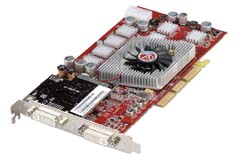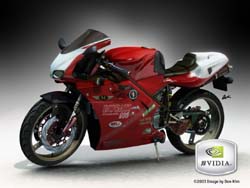
ATI
WEB SITE: www.ati.com
PRODUCT: ATI FireGL X2-256 ($999)

NVIDIA
WEB SITE: www.nvidia.com
PRODUCT: Quadro FX 3000 ($2,295); Quadro FX 3000G ($2,995)
* New cards bring increasing levels of realtime previewing to the desktop
* Both ATI and NVIDIA offer a family of high performance graphics accelerators to match users' price/performance point
* More choices for software customization
ATI and NVIDIA continue to accelerate creativity
The competition for title of "Best Graphics Accelerator on the Planet" has been raging for some time between ATI and NVIDIA. Of course the term "best" is loaded, but in terms of raw performance specs, NVIDIA currently leads with their new ultra-high end Quadro FX 3000 and FX 3000G. But ATI's newest card, the FireGL X2-256 also packs some extreme realtime hardware rendering power. While these two cards reflect the current state of the art for each company, they are both just the next installment in a family of accelerators each company offers to give the digital content creator realtime creative power at their fingertips. This realtime hardware-assisted rendering is dramatically changing the paradigm of DCC workflow. Designers and artists can see their vision come to life immediately with realtime previewing of composites at HD resolutions, and realtime previewing of complex objects, textures and lighting in applications like Maya, SoftImage|XSI, and 3DS Max.
A quick overview of the best of the best
NVIDIA's Quadro FX 3000 and FX 3000G are the company's first 256MB cards. The FX 3000G can be genlocked to an external reference and multiple cards can be frame locked and frame synced together for seamless multiple-display visualizations. These products represent the natural extension of the Quadro FX line to the HD world. In no way do they replace NVIDIA's previous top performer, the 128MB Quadro FX 2000.
Jerry Chen, NVIDIA's product manager for workstation graphics says, "the FX 3000 and FX 3000G pushes into the highest end of the market for those dealing with HD and other very high resolution texture intensive graphics. Really it's a sea-change to bring this kind of power to the desktop." The FX 3000 has more than twice the memory bandwidth of the FX 2000, and both are double-slot cards.
ATI ‘s FireGL X2-256 also has 256MB - as did its predecessor, X1-256 - of on-board RAM and a 256-bit memory bandwidth. The X2-256 differs from ATI's previous best, the X1-256, in several important respects. First, it has a different Visual Processing Unit (VPU) with more raw processing power. Second, it uses the AGP 8X/4X bus versus the AGP Pro50 bus found in the X1-256. As with NVIDIA's Quadro FX line, ATI has developed their FireGL line to be a family of workstation graphics accelerators that give users an entry point based on their budget and need.
More than just the hardware
While the hardware is the foundation of the realtime power offered by both NVIDIA's and ATI's top graphics accelerators, like any great sports car, it takes a great driver to really make it purr. Both companies provide a set of API extensions compatible with Windows and Linux.
NVIDIA has had its unified driver architecture (UDA) as a centerpiece of their product line for some time. The UDA offers a high level of stability and, more importantly, the evolution of the software over time allowing graphics cards to gain new capabilities as the driver is updated. ATI has developed a similar unified driver for FireGL, supporting workstation products ranging from FireGL T2 Mobile workstations to the X2-256. Finally, another benefit of the unified driver approach is that for larger multiple-system installations, system administration is greatly simplified.
Beyond the unified drivers, both the Quadro FX line and the FireGL line support hardware-accelerated rendering through OpenGL and Direct X extensions. This is what drives realtime previewing. A while back, NVIDIA developed the Cg language as a high level tool to allow for the creation of these customized shaders. This means users can maximize the capabilities of the graphics accelerator for each specific application. There simply wasn't a painless way to do that before Cg was developed. Since then, the OpenGL standard has finally caught up and now there's the OpenGL Shading Language (OpenGL SL) that's available for those customizations. ATI and NVIDIA both support OpenGL SL, but NVIDIA isn't abandoning support for Cg, as it still has capabilities available with it that are not found in OpenGL SL. Whatever the software path, the end result is that users can get customized software drivers for their specific applications that maximize the realtime OpenGL and Direct X performance of these graphics processors.
Lots of choices
As mentioned, both NVIDIA and ATI offer a range graphics accelerators for users while still getting the latest realtime previewing technology. NVIDIA's Quadro FX 3000 and FX 3000G represent the ultra high end of the spectrum. If you are doing lots of HD-level work with very dense textures and need the very highest of screen resolutions, and maybe genlock or frame lock capabilities, one of these is your obvious choice. Stepping down a bit from there is Quadro FX 2000, FX 1000, or FX 500, which all still offer higher-end performance, but at more aggressive price points. Likewise for ATI, their best, as mentioned, is the FireGL X2-256 which is closer in performance to between the Quadro FX 2000 and FX 1000, although it does have the 256MB of on-board memory and 256-bit memory bandwidth found in the Quadro FX 3000. If you don't mind sacrificing some performance for a more attractive price, you might look at the FireGL X1-256p, X1-128, or even Z1-128.
The important point is that both companies have developed a family of workstation-class cards that can offer OpenGL or DirectX hardware assisted rendering for realtime previewing. The level and quality of that previewing is dependent how much you're willing and able to invest. For any digital content creator, either of these product lines could benefit your workflow. Once you get a taste of realtime creativity, you realize that competition between NVIDIA and ATI is a good thing, and you want it to go on for a long, long time.